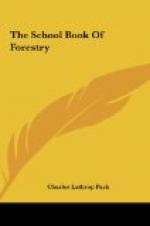Altogether 420,000,000 feet of lumber have been cut and sold from the national forests of Alaska in the past ten years. This material has been made into such products as piling, saw logs and shingle bolts. All this lumber has been used in Alaska and none of it has been exported. Much of the timber was cut so that it would fall almost into tide-water. Then the logs were fastened together in rafts and towed to the sawmills. One typical raft of logs contained more than 1,500,000 feet of lumber. It is not unusual for spruce trees in Alaska to attain a diameter of from six to nine feet and to contain 10,000 or 15,000 feet of lumber.
Southeastern Alaska has many deep-water harbors which are open the year round. Practically all the timber in that section is controlled by the Government and is within the Tongass National Forest. This means that this important crop will be handled properly. No waste of material will occur. Cutting will be permitted only where the good of the forest justifies such work.
CHAPTER XI
PROGRESS IN STATE FORESTRY
The rapid depletion and threatened exhaustion of the timber supply in the more thickly populated sections of the East has prompted several of the states to initiate action looking toward the conservation of their timber resources. As far back as 1880, a forestry commission was appointed in New Hampshire to formulate a forest policy for the State. Vermont took similar action two years later, followed within the next few years by many of the northeastern and lake states.
These commissions were mainly boards of inquiry, for the purpose of gathering reliable information upon which to report, with recommendations, for the adoption of a state forest policy. As a result of the inquiries, forestry departments were established in a number of states. The report of the New York Commission of 1884 resulted in forest legislation, in 1885, creating a forestry department and providing for the acquisition of state forests. Liberal appropriations were made from time to time for this purpose, until now the state forests embrace nearly 2,000,000 acres, the largest of any single state.
New York state forests were created, especially, for the protection of the Adirondack and Catskill regions as great camping and hunting grounds, and not for timber production. The people of the state were so fearful that through political manipulation this vast forest resource might fall into the hands of the timber exploiters, that a constitutional amendment was proposed and adopted, absolutely prohibiting the cutting of green timber from the state lands. Thus, while New York owns large areas of state forest land, it is unproductive so far as furnishing timber supplies to the state is concerned. It is held distinctly for the recreation it affords to campers and hunters, and contains many famous summer resorts.




